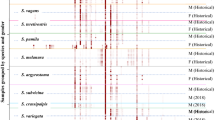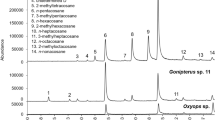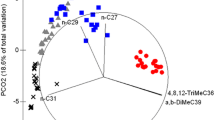Abstract
Using data from the arboreal nestingNasutitermes acajutlae (Holmgren), we propose standard collection and extraction methodology for characterization of cuticular hydrocarbons of termites under field conditions in the tropics. Specifically, we evaluated: (1) the effect of the duration and the number of extractions; (2) the effect of drying termites before extraction; (3) the effect of sample size; (4) the effect of solvents (ethanol versus hexane) on cuticular hydrocarbon profiles. Olefins comprise ca. 70% of the cuticular hydrocarbons ofN. acajutlae. Hydrocarbons consist of two distinct groups: early-eluting components, primarilyn-alkanes and methyl-branched alkanes, and late-eluting compounds, which consist almost exclusively of unsaturated components with one to six double bonds. Soldiers have more early-eluting compounds than workers or alates. Nests from the same island had qualitatively similar, but quantitatively dissimilar hydrocarbon mixtures. Brief extractions of 300 live workers in 10 ml of hexane for only 20 sec produced a hydrocarbon mixture equivalent to a 10-min extraction. Long-term extraction of 300 workers in hexane for two years resulted in different mixtures of hydrocarbons. Drying workers tended to enhance extraction of the less abundant unsaturated compounds such as C41.4 and C41.5. A single extraction of a minimum of 100 workers (live or dried), with hexane for 20 sec to 10 min is best; these extraction regimes resulted in mixtures of hydrocarbons that are quantitatively very similar. For quantitative comparisons, extracts from dried samples should not be compared to those from live samples. Storage in ethanol caused numerous unidentified, nonhydrocarbon compounds to be extracted either from the cuticle or from internal tissues.
Similar content being viewed by others
References
Blomquist, G. J., Nelson, D. R., andde Renobales, M. 1987. Chemistry, biochemistry, and physiology of insect cuticular lipids.Arch. Insect Biochem. Physiol. 6:227–265.
de Renobales, M., Nelson, D. R., andBlomquist, G. J. 1991. Cuticular lipids, pp. 240–251,in K. Binnington andA. Retnakaran (eds.). Physiology of the Insect Epidermis. CSIRO, Melbourne, Australia.
Haverty, M. I. Page, M., Nelson, L. J., andBlomquist, G. J. 1988. Cuticular hydrocarbons of dampwood termites,Zootermopsis: Intra- and intercolony variation and potential as taxonomic characters.J. Chem. Ecol. 14:1035–1058.
Haverty, M. I., Nelson, L. J., andPage, M. 1990a. Cuticular hydrocarbons of four populations ofCoptotermes formosanus Shiraki in the United States: Similarities and origins of introductions.J. Chem. Ecol. 16:1635–1647.
Haverty, M. I., Thorne, B. L., andPage, M. 1990b. Surface hydrocarbon components of two species ofNasutitermes from Trinidad..J. Chem. Ecol. 16:2441–2450.
Haverty, M. I., Nelson, L. J., andPage, M. 1991a. Preliminary investigations of the cuticular hydrocarbons of North AmericanReticulitermes and tropicalCoptotermes (Isoptera: Rhinotermitidae) for chemosystematic studies.Sociobiology 19:51–76.
Haverty, M. I., Page, M., Thorne, B. L., andEscoubas, P. 1991b. Cuticular hydrocarbons: Species and population-level discrimination in termites, pp. 15–23,in M. I. Haverty andW. W. Wilcox (tech. coords.). Proceedings of the Symposium on Current Research on Wood-Destroying Organisms and Future Prospects for Protecting Wood in Use. Western Forest Insect and Disease Work Conference, Bend. Oregon. September 13, 1989. USDA Forest Service Gen. Tech. Report PSW-128.
Haverty, M. I., Nelson, L. J., Thorne, B. L., Collins, M. S., Darlington, J. P. E. C., andPage, M. 1992. Cuticular hydrocarbons for species determination of tropical termites, pp. 58–66,in C. E. Conrad andL. A. Newell (tech. coords.). Proceedings of the Session on Tropical Forestry for People of the Pacific. Pacific Science Congress, Honolulu, Hawaii, May 22–28. 1991. USDA Forest Service Gen. Tech. Report PSW-129.
Haverty, M. I., Collins, M. S., Nelson, L. J., andThorne, B. L. 1997. Cuticular hydrocarbons of the termites of the British Virgin Islands.J. Chem. Ecol. Submitted.
Haverty, M. I., Grace, J. K., Nelson, L. J., andYamamoto, R. T. 1996. Intercaste, intercolony, and temporal variation of cuticular hydrocarbon mixtures ofCoptotermes formosanus (Isoptera: Rhinotermitidae).J. Chem. Ecol. 22:1813–1834.
Howard, R. W., McDaniel, C. A., andBlomquist, G. J. 1978. Cuticular hydrocarbons of the eastern subterranean termite,Reticulitermes flavipes (Kollar) (Isoptera: Rhinotermitidae).J. Chem. Ecol. 4:233–245.
Howard, R. W., McDaniel, C. A., andBlomquist, G. J. (1980). Chemical mimicry as an integrating mechanism: Cuticular hydrocarbons of a termitophile and its host.Science 210:431–433.
Howard, R. W., McDaniel, C. A., andBlomquist, G. J. 1982b. Chemical mimicry as an integrating mechanism for three termitophiles associated withReticulitermes virginicus (Banks).Psyche 89:157–167.
Howard, R. W., McDaniel, C. A., Nelson, D. R., Blomquist, G. J., Gelbaum, L. T., andZalkow, L. H. 1982a. Cuticular hydrocarbons ofReticulitermes virginicus (Banks) and their role as potential species- and caste-recognition cues.J. Chem. Ecol. 8:1227–1239.
Howard, R. W., Thorne, B. L., Levings, S. C., andMcDaniel, C. A. 1988. Cuticular hydrocarbons as chemotaxonomic characters forNasuititermes corniger (Motschulsky) andN. ephratae (Holmgren) (Isoptera: Termitidae).Ann. Entomol. Soc. Am. 81:395–399.
Howard, R. W., Howard, C. D., andColquhoun, S. 1995. Ontogenetic and environmentally induced changes in the cuticular hydrocarbons ofOryzaephilus surinamensis (Coleoptera: Cucujidae).Ann. Entomol. Soc. Am. 88:485–495.
Moore, B. P. 1969. Biochemical studies in termites, pp. 407–432,in F. M. Weesner andK. Krishna (eds.). Biology of Termites, Vol. I. Academic Press, New York.
Scheffrahn, R. H., Darlington, J. P. E. C., Collins, M. S., Krecek, J., andSu, N.-Y. 1994. Termites (Isoptera: Kalotermitidae. Rhinotermitidae, Temitidae) of the West Indies.Sociobiology 24:213–238.
Steel, R. G. D., andTorrie, J. H. 1960. Principles and Procedures of Statistics. McGraw-Hill, New York, 481 pp.
Thorne, B. L. 1985. Numerical and biomass caste proportions in colonies of the termitesNasutitermes corniger andN. ephratae.Insectes Soc. 32:411–426.
Thorne, B. L., andHaverty, M. I. 1989. Accurate identification ofZootermopsis species (Isoptera: Termopsidae) based on a mandibular character of nonsoldier castes.Ann. Entomol. Soc. Am. 82:262–266.
Thorne, B. L., Haverty, M. I., Page, M., andNutting, W. L. 1993. Distribution and biogeography of the North American termite genusZootermopsis (Isoptera: Termopsidae).Ann. Entomol. Soc. Am. 86:532–544.
Thorne, B. L. Haverty, M. I., andCollins, M. S. 1994. Taxonomy and biogeography ofNasutitermes acajutlae andN. nigriceps (Isoptera: Termitidae) in the Caribbean and Central America.Ann. Entomol. Soc. Am. 87:762–770.
Author information
Authors and Affiliations
Rights and permissions
About this article
Cite this article
Haverty, M.I., Thorne, B.L. & Nelson, L.J. Hydrocarbons ofNasutitermes acajutlae and comparison of methodologies for sampling cuticular hydrocarbons of caribbean termites for taxonomic and ecological studies. J Chem Ecol 22, 2081–2109 (1996). https://doi.org/10.1007/BF02040096
Received:
Accepted:
Issue Date:
DOI: https://doi.org/10.1007/BF02040096




